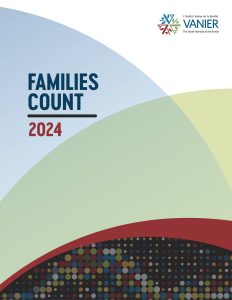Projects
Families Count
Vanier Institute’s new resource explores three decades of change, continuity, and complexity among families in Canada. Released during the International Year of the Family’s 30th anniversary, Families Count provides statistical portraits of families in Canada, highlights trends over time, and offers insights on what it all means for families and family life.
Chapter 28 – Women are more likely than men to choose self-employment for work–family balance
Self-employment is diverse, ranging from solo self-employment, where one person operates a business or works as a consultant on their own, to a larger, incorporated business with many employees. The overall rate of self-employment within the labour force has seen little change over the last half century. In 2023, for example, 13.2% of workers in Canada aged 15 and older were self-employed compared with 15.5% in 1994.1 This was only slightly higher than the rate of 12.2% in 1976. Nearly two-thirds (62.9%) of the self-employed workforce were men in 2023, down from 73.7% in 1976.
Among those aged 25 to 54, 10% of women and 15% of men were self-employed.2 Workers aged 55 and older were the most likely to be self-employed, and the only age group that saw a notable increase since 1976. Between 1976 and 2022, the percentage of women workers in this age group who were self-employed increased from 14% to 18%, compared with an increase from 23% to 27% among men.
Many workers are “pulled” to self-employment, choosing this work arrangement because of the independence and perceived flexibility it can provide. Others are “pushed” due to negative economic conditions, difficulties finding suitable employment, or for other reasons.3 In 2023, the most common reason for being self-employed was to have autonomy and control over work hours, wage rates, or location (36.5% for women and 39.2% for men). Women (5.2%) were less likely than men (11.8%) to view self-employment as a way to earn more money.
Women (12.4%) were also more likely than men (8.9%) to cite being self-employed for better work–life balance, to experience less stress, or for health reasons.3 Earlier (2018) data showed that self-employed women, aged 15 and older, were more than three times as likely as men (15.4% vs. 4.6%) to have cited work–family balance as their main reason for having this type of work arrangement.4 Research has shown that families may coordinate periods of self-employment for childcare reasons.5
Why this matters
Self-employment can offer some advantages and greater flexibility for workers and their families compared with wage and salary contracts. Even so, there can be some challenges for families. Data show that self-employed workers are far more likely to work long hours than employees. In 2021, more than one-quarter of self-employed workers aged 15 and older (26.4%) reported working more than 49 hours per week, compared with 5.3% of employees who regularly did so.6 Therefore, the long work hours of self-employment may contribute to less time available for family, leisure, and health-related activities.
Solo self-employment (one person operating a business on their own) is considered to be precarious.7 There may be challenges related to the work–family interface, such as lack of access to programs and policies that can support family responsibilities,8 including health benefits, paid sick days, and vacation time. Further, the lack of work stability means lower levels of income stability, which can undermine the material wellbeing of families.
Many self-employed workers share employment characteristics with those who engage in “gig work,” such as having less employment stability; having no employees, partners, or premises dedicated to their business; and either working short hours or having an unstable client base. “Gig work” is defined by Statistics Canada as “a form of employment characterized by short-term jobs or tasks which does not guarantee steady work and where the worker must take specific actions to stay employed.”9 Statistics Canada estimated that in December 2023 more than one-quarter (26.6%) self-employed people in Canada aged 15 to 69 were gig workers.3
Source: Statistics Canada. (2024, January 5). Table 14-10-0027-01 Employment by class of worker, annual (x 1,000).1
References
- Statistics Canada. (2024, January 5). Table 14-10-0027-01 Employment by class of worker, annual (x 1,000). https://doi.org/10.25318/1410002701-eng ↩︎
- Uppal, S. (2023, December 4). Self-employment among women in Canada. Insights on Canadian Society. https://www150.statcan.gc.ca/n1/pub/75-006-x/2023001/article/00014-eng.htm ↩︎
- Lovei, M., & Hardy, V. (2024, June 3). Experiences of self-employed workers in Canada, 2023. Labour Statistics at a Glance. https://www150.statcan.gc.ca/n1/pub/71-222-x/71-222-x2024001-eng.htm ↩︎
- Yssaad, L., & Ferrao, V. (2019, May 28). Self-employed Canadians: Who and why? Labour Statistics at a Glance. https://www150.statcan.gc.ca/n1/pub/71-222-x/71-222-x2019002-eng.htm ↩︎
- Lloyd, N. (2020). Strategic self-employment and family formation. Working Paper Series, 20. https://www.econstor.eu/bitstream/10419/215771/1/1694283755.pdf ↩︎
- Statistics Canada. (2022, May 30). Long working hours, 1976 to 2021. Quality of Employment in Canada. https://www150.statcan.gc.ca/n1/pub/14-28-0001/2020001/article/00009-eng.htm ↩︎
- May, B. (2019, June). Precarious Work: Understanding the Changing Nature of Work in Canada. Report of the Standing Committee on Human Resources, Skills and Social Development and the Status of Persons with Disabilities. https://www.ourcommons.ca/Content/Committee/421/HUMA/Reports/RP10553151/humarp19/humarp19-e.pdf ↩︎
- Hilbrecht, M. (2016). Self-employment and experiences of support in a work-family context. Journal of Small Business and Entrepreneurship, 28(1), 75–96. https://doi.org/10.1080/08276331.2015.1117878 ↩︎
- Statistics Canada. (2024, March 4). Defining and measuring the gig economy using survey data. Labour Statistics: Research Papers. https://www150.statcan.gc.ca/n1/pub/75-004-m/75-004-m2024001-eng.htm ↩︎

Families Count 2024 is a publication of the Vanier Institute of the Family that provides accurate and timely information on families and family life in Canada. Written in plain language, it features chapters on diverse topics and trends that have shaped families in Canada. Its four sections (Family Structure, Family Work, Family Identity, and Family Wellbeing) are guided by the Family Diversities and Wellbeing Framework.
The Vanier Institute of the Family
94 Centrepointe Drive
Ottawa, Ontario K2G 6B1
[email protected]
www.vanierinstitute.ca

This work is licensed under a Creative Commons Attribution-Noncommercial 4.0 International license.
How to cite this document:
Battams, N. (2024). Women are more likely than men to choose self-employment for work–family balance. In Families count 2024, The Vanier Institute of the Family. https://vanierinstitute.ca/families-count-2024/women-are-more-likely-than-men-to-choose-self-employment-for-work-family-balance
